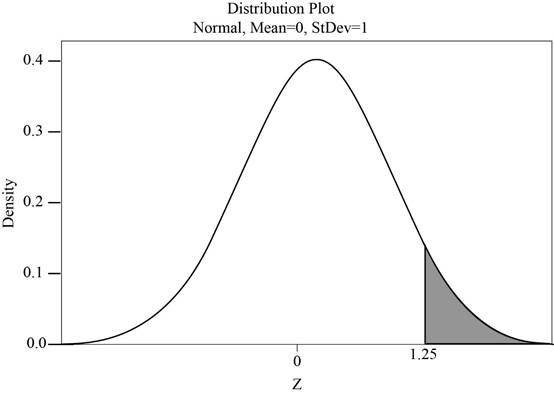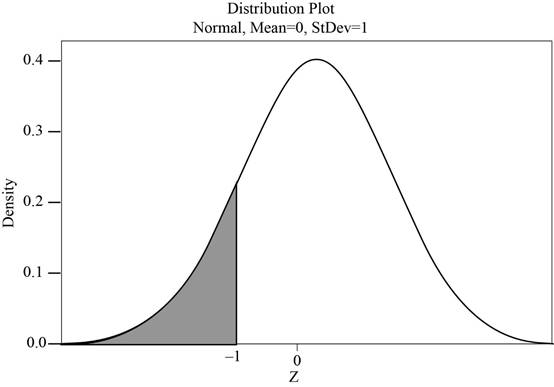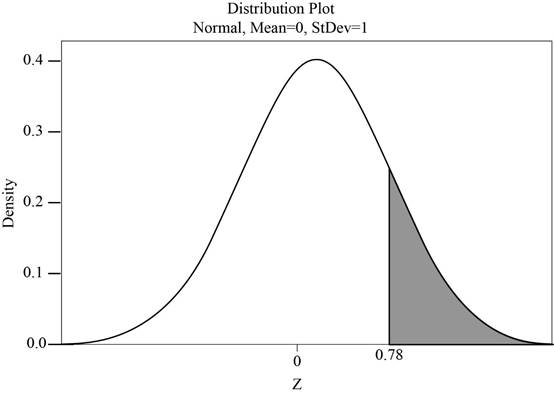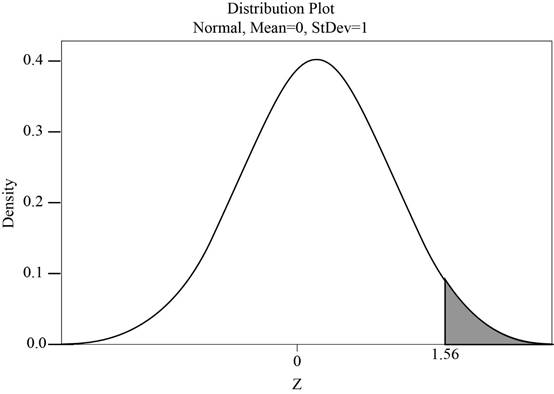
Concept explainers
The manufacture of a certain part requires two different machine operations. The time on machine 1 has
a. What is the
b. What is the probability that the total time used by machine 2 is less than 55 hours?
c. What is the probability that the total time used by both machines together is greater than 115 hours?
d. What is the probability that the total time used by machine 1 is greater than the total time used by machine 2?
a.
Find the probability that the total time used by machine 1 is greater than 55 hours.
Answer to Problem 18E
The probability that the total time used by machine 1 is greater than 55 hours is 0.1056.
Explanation of Solution
Given info:
The mean and standard deviation of the time on machine 1 is 0.5 hours and 0.4 hours. The mean and standard deviation of the time on machine 2 is 0.6 hours and 0.5 hours. The time taken by both the machines are independent. The total number of parts manufactured is 100.
Calculation:
The Central Limit Theorem:
The random variables
The sample mean is
Then if n is sufficiently large,
The random variables
Then for machine 1, the mean is,
The total time on machine 1 is
Then by the central limit theorem
Mean:
Substitute n as 100 and
Standard deviation:
Substitute n as 100 and
Also by the central limit theorem
Mean:
Substitute n as 100 and
Standard deviation:
Substitute n as 100 and
The required probability is,
The formula to convert
Substitute 50 for
The above probability can be obtained by finding the areas to the left of 1.25.
The shaded region represents the area to the right of 1.25 is shown below:

Use Table A.2: Cumulative Normal Distribution to find the area.
Procedure:
For z at 1.25,
- Locate 1.2 in the left column of the Table A.2.
- Obtain the value in the corresponding row below 0.05.
That is,
Then,
Thus, probability that the total time used by machine 1 is greater than 55 hours is 0.1056.
b.
Find the probability that the total time used by machine 2 is less than 55 hours.
Answer to Problem 18E
The probability that the total time used by machine 2 is less than 55 hours is 0.1587.
Explanation of Solution
Calculation:
The required probability is,
Substitute 60 for
The above probability can be obtained by finding the areas to the left of –1.
The shaded region represents the area to the left of –1 is shown below:

Use Table A.2: Cumulative Normal Distribution to find the area.
Procedure:
For z at –1,
- Locate –1.0 in the left column of the Table A.2.
- Obtain the value in the corresponding row below 0.00.
That is,
Then,
Thus, the probability that the total time used by machine 2 is less than 55 hours is 0.1587.
c.
Find the probability that total time used by both machines together is greater than 115 hours.
Answer to Problem 18E
The probability that total time used by both machines together is greater than 115 hours is 0.2177.
Explanation of Solution
Calculation:
Result:
Assume that X and Y are independent random variables with X follows Normal with mean
Total time used by both machines is denoted as
Substitute
The standard deviation is,
Substitute
The required probability is,
Substitute 110 for
The above probability can be obtained by finding the areas to the left of 0.78.
The shaded region represents the area to the right of 0.78 is shown below:

Use Table A.2: Cumulative Normal Distribution to find the area.
Procedure:
For z at 0.78,
- Locate 0.7 in the left column of the Table A.2.
- Obtain the value in the corresponding row below 0.08.
That is,
Then,
Thus, the value of
d.
Find the probability that total time used by both machine 1 is greater than the total time used by machine 2.
Answer to Problem 18E
The probability that total time used by both machine 1 is greater than the total time used by machine 2 is 0.0594.
Explanation of Solution
Calculation:
The difference between the time on machine 1 and the time on machine2 is denoted as
Substitute
The standard deviation is,
Substitute
The required probability is,
Substitute –10 for
The above probability can be obtained by finding the areas to the left of 1.56.
The shaded region represents the area to the right of 1.56 is shown below:

Use Table A.2: Cumulative Normal Distribution to find the area.
Procedure:
For z at 1.56,
- Locate 1.5 in the left column of the Table A.2.
- Obtain the value in the corresponding row below 0.06.
That is,
Then,
Thus, the value of
Want to see more full solutions like this?
Chapter 4 Solutions
Statistics for Engineers and Scientists
- Consider the hypothesis test Ho: = 622 against H₁: 6 > 62. Suppose that the sample sizes are n₁ = 20 and n₂ = 8, and that = 4.5; s=2.3. Use a = 0.01. (a) Test the hypothesis. Round your answers to two decimal places (e.g. 98.76). The test statistic is fo = i The critical value is f = Conclusion: i the null hypothesis at a = 0.01. (b) Construct the confidence interval on 02/022 which can be used to test the hypothesis: (Round your answer to two decimal places (e.g. 98.76).) iarrow_forward2011 listing by carmax of the ages and prices of various corollas in a ceratin regionarrow_forwardس 11/ أ . اذا كانت 1 + x) = 2 x 3 + 2 x 2 + x) هي متعددة حدود محسوبة باستخدام طريقة الفروقات المنتهية (finite differences) من جدول البيانات التالي للدالة (f(x . احسب قيمة . ( 2 درجة ) xi k=0 k=1 k=2 k=3 0 3 1 2 2 2 3 αarrow_forward
- 1. Differentiate between discrete and continuous random variables, providing examples for each type. 2. Consider a discrete random variable representing the number of patients visiting a clinic each day. The probabilities for the number of visits are as follows: 0 visits: P(0) = 0.2 1 visit: P(1) = 0.3 2 visits: P(2) = 0.5 Using this information, calculate the expected value (mean) of the number of patient visits per day. Show all your workings clearly. Rubric to follow Definition of Random variables ( clearly and accurately differentiate between discrete and continuous random variables with appropriate examples for each) Identification of discrete random variable (correctly identifies "number of patient visits" as a discrete random variable and explains reasoning clearly.) Calculation of probabilities (uses the probabilities correctly in the calculation, showing all steps clearly and logically) Expected value calculation (calculate the expected value (mean)…arrow_forwardif the b coloumn of a z table disappeared what would be used to determine b column probabilitiesarrow_forwardConstruct a model of population flow between metropolitan and nonmetropolitan areas of a given country, given that their respective populations in 2015 were 263 million and 45 million. The probabilities are given by the following matrix. (from) (to) metro nonmetro 0.99 0.02 metro 0.01 0.98 nonmetro Predict the population distributions of metropolitan and nonmetropolitan areas for the years 2016 through 2020 (in millions, to four decimal places). (Let x, through x5 represent the years 2016 through 2020, respectively.) x₁ = x2 X3 261.27 46.73 11 259.59 48.41 11 257.96 50.04 11 256.39 51.61 11 tarrow_forward
- If the average price of a new one family home is $246,300 with a standard deviation of $15,000 find the minimum and maximum prices of the houses that a contractor will build to satisfy 88% of the market valuearrow_forward21. ANALYSIS OF LAST DIGITS Heights of statistics students were obtained by the author as part of an experiment conducted for class. The last digits of those heights are listed below. Construct a frequency distribution with 10 classes. Based on the distribution, do the heights appear to be reported or actually measured? Does there appear to be a gap in the frequencies and, if so, how might that gap be explained? What do you know about the accuracy of the results? 3 4 555 0 0 0 0 0 0 0 0 0 1 1 23 3 5 5 5 5 5 5 5 5 5 5 5 5 6 6 8 8 8 9arrow_forwardA side view of a recycling bin lid is diagramed below where two panels come together at a right angle. 45 in 24 in Width? — Given this information, how wide is the recycling bin in inches?arrow_forward
- 1 No. 2 3 4 Binomial Prob. X n P Answer 5 6 4 7 8 9 10 12345678 8 3 4 2 2552 10 0.7 0.233 0.3 0.132 7 0.6 0.290 20 0.02 0.053 150 1000 0.15 0.035 8 7 10 0.7 0.383 11 9 3 5 0.3 0.132 12 10 4 7 0.6 0.290 13 Poisson Probability 14 X lambda Answer 18 4 19 20 21 22 23 9 15 16 17 3 1234567829 3 2 0.180 2 1.5 0.251 12 10 0.095 5 3 0.101 7 4 0.060 3 2 0.180 2 1.5 0.251 24 10 12 10 0.095arrow_forwardstep by step on Microssoft on how to put this in excel and the answers please Find binomial probability if: x = 8, n = 10, p = 0.7 x= 3, n=5, p = 0.3 x = 4, n=7, p = 0.6 Quality Control: A factory produces light bulbs with a 2% defect rate. If a random sample of 20 bulbs is tested, what is the probability that exactly 2 bulbs are defective? (hint: p=2% or 0.02; x =2, n=20; use the same logic for the following problems) Marketing Campaign: A marketing company sends out 1,000 promotional emails. The probability of any email being opened is 0.15. What is the probability that exactly 150 emails will be opened? (hint: total emails or n=1000, x =150) Customer Satisfaction: A survey shows that 70% of customers are satisfied with a new product. Out of 10 randomly selected customers, what is the probability that at least 8 are satisfied? (hint: One of the keyword in this question is “at least 8”, it is not “exactly 8”, the correct formula for this should be = 1- (binom.dist(7, 10, 0.7,…arrow_forwardKate, Luke, Mary and Nancy are sharing a cake. The cake had previously been divided into four slices (s1, s2, s3 and s4). What is an example of fair division of the cake S1 S2 S3 S4 Kate $4.00 $6.00 $6.00 $4.00 Luke $5.30 $5.00 $5.25 $5.45 Mary $4.25 $4.50 $3.50 $3.75 Nancy $6.00 $4.00 $4.00 $6.00arrow_forward
 Glencoe Algebra 1, Student Edition, 9780079039897...AlgebraISBN:9780079039897Author:CarterPublisher:McGraw Hill
Glencoe Algebra 1, Student Edition, 9780079039897...AlgebraISBN:9780079039897Author:CarterPublisher:McGraw Hill

- Algebra & Trigonometry with Analytic GeometryAlgebraISBN:9781133382119Author:SwokowskiPublisher:Cengage
 College AlgebraAlgebraISBN:9781305115545Author:James Stewart, Lothar Redlin, Saleem WatsonPublisher:Cengage Learning
College AlgebraAlgebraISBN:9781305115545Author:James Stewart, Lothar Redlin, Saleem WatsonPublisher:Cengage Learning




